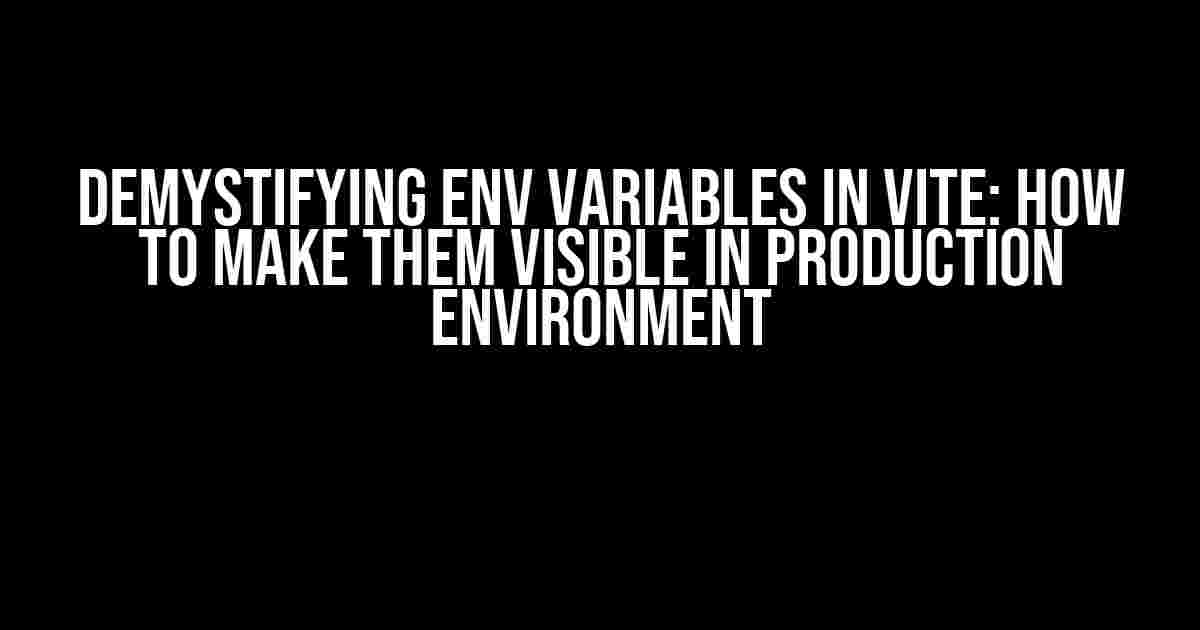Are you tired of scratching your head over environment variables in Vite? Do you wonder why they seem to disappear in production mode? Fear not, dear developer, for we’re about to unveil the secrets of env variables in Vite and make them visible in the production environment.
What are Environment Variables?
Environment variables are values set outside of your code that can influence the behavior of your application. They’re like secret ingredients in your favorite recipe, and in Vite, they play a crucial role in configuring your app for different environments.
Why Do Env Variables Matter in Vite?
Vite, a popular build tool, uses environment variables to separate configuration for development, staging, and production environments. By default, Vite exposes environment variables in development mode, but things get tricky when you switch to production mode. In this article, we’ll explore why env variables become invisible in production and how to make them visible again.
The Mysterious Case of Disappearing Env Variables
When you run `vite build` or `vite build –mode production`, you might notice that your environment variables seem to vanish into thin air. This is because Vite, by design, strips out environment variables from the production build by default. But why would Vite do such a thing?
The reason lies in security and performance. In production mode, Vite assumes you want to minimize the attack surface and optimize performance. By removing environment variables, Vite helps prevent sensitive data exposure and reduces the bundled code size. However, this “protection” can become a hurdle when you need to access env variables in your production code.
Solving the Env Variable Visibility Issue
Fear not, dear developer! We’ve got a few tricks up our sleeve to make env variables visible in production mode.
Method 1: Using the `env` Option in `vite.config.js`
In your `vite.config.js` file, add the following code:
import { defineConfig } from 'vite';
export default defineConfig({
build: {
env: {
MY_VAR: 'my-value',
},
},
});In this example, we’re defining a `MY_VAR` environment variable with the value `my-value`. This variable will now be available in your production code.
Method 2: Using a `publicRuntimeConfig` in `vite.config.js`
In your `vite.config.js` file, add the following code:
import { defineConfig } from 'vite';
export default defineConfig({
build: {
publicRuntimeConfig: {
MY_VAR: 'my-value',
},
},
});The `publicRuntimeConfig` option allows you to expose environment variables to the runtime environment, making them accessible in your production code.
Method 3: Using an External Configuration File
Create a separate file, e.g., `env.config.js`, with the following content:
export default {
MY_VAR: 'my-value',
};Then, in your `vite.config.js` file, import the external configuration file:
import { defineConfig } from 'vite';
import envConfig from './env.config';
export default defineConfig({
build: {
env: envConfig,
},
});This approach allows you to manage your environment variables in a separate file, making it easier to update and maintain them.
Best Practices for Working with Env Variables in Vite
Now that you know how to make env variables visible in production mode, here are some best practices to keep in mind:
- Use environment variables for configuration only: Avoid storing sensitive data or secrets in environment variables. Instead, use secure storage solutions like environment files or secrets management tools.
- Keep env variables organized: Use a consistent naming convention and group related variables together for better maintainability.
- Document your env variables: Clearly document the purpose and expected values for each environment variable in your codebase.
- Test and verify env variables: Ensure that your environment variables are correctly set and updated in your development and production environments.
Conclusion
Env variables in Vite might seem mysterious at first, but with the right approaches, you can make them visible and manageable in your production environment. By following the methods and best practices outlined in this article, you’ll be able to harness the power of environment variables and take your Vite-based application to the next level.
| Method | Description |
|---|---|
| Using the `env` option in `vite.config.js` | Define env variables directly in `vite.config.js` |
| Using a `publicRuntimeConfig` in `vite.config.js` | Expose env variables to the runtime environment |
| Using an external configuration file | Manage env variables in a separate file |
Now, go forth and conquer the world of environment variables in Vite!
Frequently Asked Question
Get ready to uncover the secrets of Env variables in Vite build production environment!
Q: Are Env variables automatically included in the Vite build production environment?
A: Nope! By default, Env variables are not automatically included in the Vite build production environment. You need to use the `build.env` option in your `vite.config.js` file to specify which Env variables should be exposed.
Q: How do I expose an Env variable to the Vite build production environment?
A: Easy peasy! You can expose an Env variable by setting it in your `vite.config.js` file using the `build.env` option. For example: `build: { env: { API_KEY: ‘my-secret-key’ } }`. This will make the `API_KEY` Env variable available in your production environment.
Q: Can I use Env variables in my JavaScript code in the Vite build production environment?
A: Yes, you can! Once you’ve exposed an Env variable using the `build.env` option, you can access it in your JavaScript code using the `import.meta.env` object. For example: `const apiKey = import.meta.env.API_KEY;`.
Q: Are Env variables visible to clients in the Vite build production environment?
A: No way, José! Env variables are only visible on the server-side and are not sent to clients in the Vite build production environment. This means you can keep your sensitive data safe and secure.
Q: Can I use Env variables with Vite’s build optimization features?
A: Absolutely! Vite’s build optimization features, such as minification and tree shaking, work seamlessly with Env variables. You can take advantage of these features to optimize your code while still using Env variables to configure your application.
